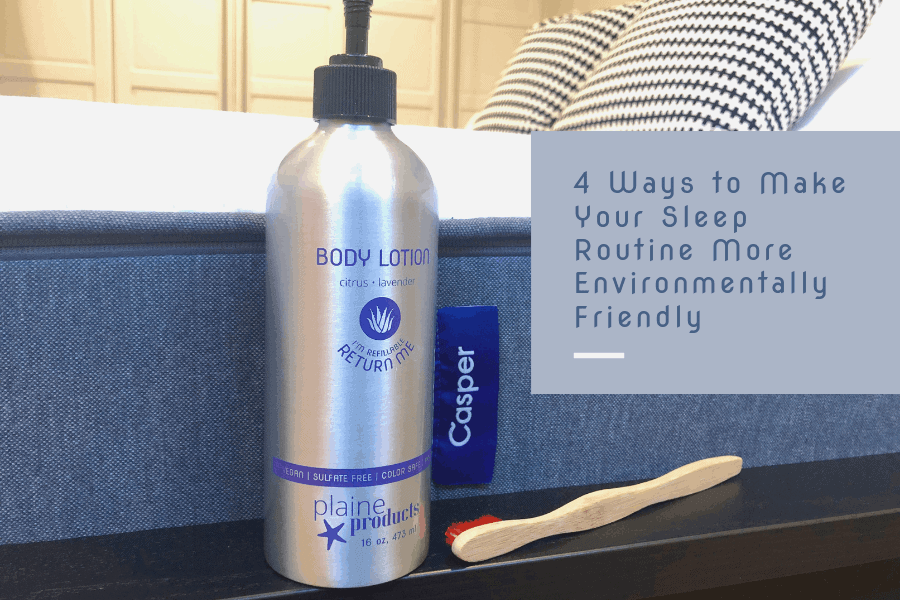If you’re environmentally conscious, you may spend all day trying to minimize your ecological impact. Bedtime is the time of day you don’t have to worry about anything, right? Not quite. While you might not think of bedtime as an opportunity to make a big impact, there are many parts of your routine that can be changed to make a difference. From your hygiene to the mattress you sleep on, here are four ways to make your sleep routine more environmentally friendly.
1. Upgrade Your Toothbrush
Most likely, you’re going to be brushing your teeth before bed. Almost all toothbrushes are made of a plastic handle and plastic bristles, not environmentally friendly. While not recyclable in their existing form, there are toothbrush recycling programs that separate the components and reuse what they can to make new toothbrushes. Once your current brush has lived a full life, consider eliminating the plastic for a compostable option like bamboo. The wood handles can be composted or will biodegrade in a waste stream far quicker than a plastic handle. With the exception of boar hair bristles, almost all bristles will be non-compostable. Just be sure to separate your bristles before tossing the handle in your compost pile or to use as kindling for a fire.
2. Use Natural Skincare Products and Reuse Containers
The products we use to achieve smooth skin can come at a price. It’s good to consider reducing packaging waste and plastics when buying and using these items. Using a lotion or moisturizer right before bed is a great way to wake up with skin that feels refreshed and hydrated. Applying lotion at night is great for your skin, but can be bad for the landfill if not done correctly.
Even if you recycle your current lotion bottle, the pumps aren’t recyclable and will end up in the landfill. Worse, if non-recyclable items are mixed with other recyclables, some facilities will divert the entire load to the trash. If your lotion or moisturizer comes in a squeeze tube, these are often not recyclable and will end up directly in the trash. Consider using refillable containers for your lotion. This ensures you can reuse the pump and refill the bottle, eliminating single-use plastic from your bedtime beauty routine.
Any product you use on your body will partly end up down the drain when you shower, so it’s important that your products are safe for the environment. Even if your town has a great wastewater treatment plan, look for products that are designed to biodegrade and are free of chemicals that can harm fish and wildlife.
3. Repurpose Those Pill Bottles
For those who take medication, pill bottles will be a regular part of pre-sleep prep. Due to safety regulations, you can’t just ask your pharmacist to refill your current bottle. Get the most life out of these plastics by repurposing them. Tight-sealing caps and see-through visibility make them great for storing dry tinder for camping or for organizing small items for arts and crafts. Most pill bottles are made of #1, #2, or #5 plastics, which are accepted by many recycling programs. Your local pharmacy may also have a pill bottle takeback program – but be sure to ask if they reuse or recycle them.
4. Embrace Environmentally Friendly Bedding
Center stage in the bedroom is your mattress. If you have one you enjoy, that’s great. Make sure to take care of it so it doesn’t wear out prematurely. If your bed is beyond its years, the good news is that mattresses are almost 100% recyclable. Foam is shredded to make carpet padding, steel is easy to recover and reuse, and fibers can be respun into new clothing or fabrics.
When it’s time to replace a big ticket item like a mattress, consider the impact it will have. It’s important that your bed is made with sustainable materials where possible. Modern foam beds will often include a layer of latex, which is from the sap of a rubber tree. This natural material is safe and completely recyclable. Some beds will also offer a cover made of wool instead of synthetic fiber. Wool is soft but durable and is a great natural alternative to synthetics. Look for certifications like OEKO-TEX or CertiPur. These ensure that your mattress is free of harmful chemicals, PBDE flame retardants, or ozone depleters.
Efficient shipping methods are also important to keep in mind when shopping for a new, eco-friendly mattress. Years ago, the only way to buy a bed was to drive to a store, pick the one you liked, and have it delivered to your house. Before it got to the store, it was likely on a truck filled with other mattresses. Nowadays, you can order a bed right online, and it will appear at your doorstep. To accomplish this, bed-in-a-box companies like Casper found ways to ship a king-size bed in a 3.5-foot box. Not only are they satisfying to watch expand, but they also demonstrate shipping efficiency by being direct-to-consumer and saving space on trucks.
You don’t have to change your entire nighttime routine to make a big impact on your world. Small steps to recognize and reduce single-use plastics can make a big difference. When bigger bedroom purchases are being considered, awareness of the products and materials available will help you make the best decision for your health and the environment. So you can rest a little easier at night knowing you’ve taken the time to overhaul your sleep routine to be more environmentally friendly!




